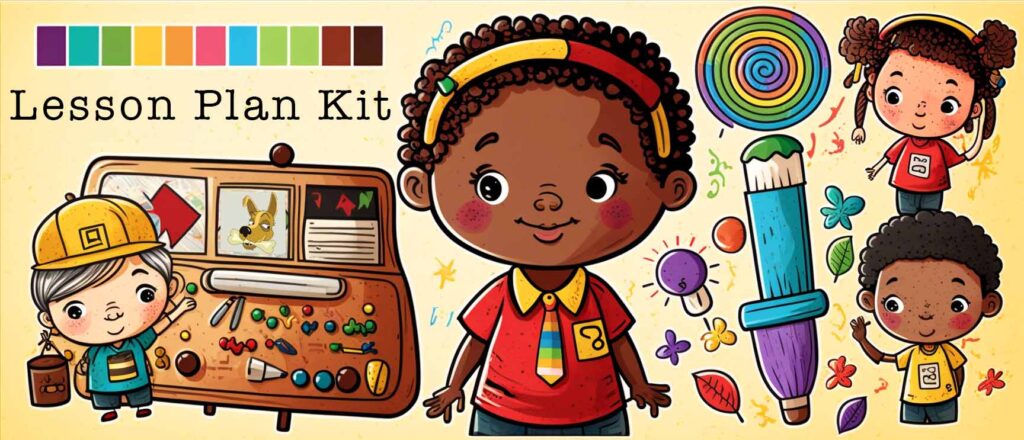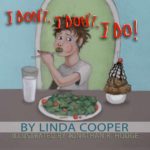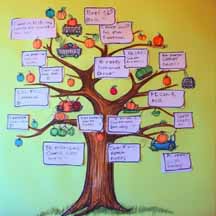Purchase I Don't! I Don't! I Do!
This free lesson plan is based upon the I Don't! I Don't! I Do! book.


Age group: Preschool through First Grade (3-6 years old)
1. "I Don’t! I Don’t! I Do!" - A Popular Children's Book for Social-Emotional Learning by Linda Cooper
2. Interactive Teaching Tools: Whiteboard or flip chart and markers
3. Coloring Pages Depicting Scenarios from the Book (included, free)
4. Crayons or Colored Pencils for Creative Expression
5. Decision Tree Template for First Graders: Older Students Apply Concepts Hands-On (included, free)
1. Students will grasp the concept of decision-making – a key element in developing social-emotional skills.
2. Students will identify and discuss personal examples of everyday decisions, fostering critical thinking.
3. Students will understand the cause and effect in relation to their decisions, promoting a sense of responsibility.
Linda Cooper, an experienced educator who taught English in New Orleans high schools and English as a Second Language at Tulane University, found inspiration for her book, I Don’t. I Don’t. I Do!, after years of contemplation. The idea emerged one morning, swirling in her thoughts, and patiently developed while she devoted her time to raising children and teaching.
Throughout this period, Cooper observed the relevance of the book’s premise to various adults, including students pursuing higher education and teachers diligently grading papers to earn their livelihood. This notion even resonated with renowned writers like Dorothy Parker, who famously expressed, ‘I hate writing; I love having written.’
Cooper acknowledged the undeniable truth behind these sentiments and decided it was time to bring her idea to fruition. With determination, she transformed I DON’T into I DO!
Within the pages of this engaging picture book, a young child faces a series of decisions, each accompanied by a resolute 'I Don't.' He resists turning off the TV, eating his spinach, cleaning up his mess, and even taking a bath. However, he soon realizes that avoiding these tasks can lead to troublesome consequences, potentially resulting in a very unpleasant day. Fortunately, the book unveils a secret solution to his predicaments. Through rhythmic prose and vibrant illustrations, it vividly demonstrates how acts of sharing snacks, taking naps, and embracing turn-taking can pave the way for enjoyable moments of play and making friends. This heartwarming bedtime story offers children valuable insights into resolving their own everyday dilemmas, in the spirit of I Don’t. I Don’t. I Do!
Amazon sells the paperback and Kindle e-book version of the book.
You can also get a copy for Apple Books, Google Play, or Barnes & Noble Nook

These don’t come from the book but are ideas of how children can make their own I Don’t! I Don’t! I Do! concepts.

I don't want to share my candy. I don't want to have less for myself. But I do want my friends to enjoy it with me and be happy.

I don't want to clean up after class. I don't want to pick up other people's trash. But I do want a clean classroom where we all can learn better.

I don't want to wait in line. I don't want to stand still. But I do want everyone to get their fair turn.

I don't want to say I'm sorry. I don't want to admit I was wrong. But I do want to make things right and be a good friend.

I don't want to stop playing with my favorite toy. I don't want to share it. But I do want to play together with my friend and have fun.

I don't want to leave my game. I don't want to help my friend pick up their dropped books. But I do want them to feel better and not be upset.

I don't want to wait my turn. I don't want to let others go first. But I do want to play the game fairly and keep everyone happy.

I don't want to change our game. I don't want to play something different. But I do want the new student to feel welcome and included.
Purchase I Don't! I Don't! I Do!
This free lesson plan is based upon the I Don't! I Don't! I Do! book.
Setup Whiteboard or Flip Chart
Be sure your classroom has a flip chart or white board ready for the lesson.
Crayons or Colored Pencils
Be sure to get your students' crayons or colored pencils ready for kids to get creative!
Coloring Pages
We have provided free coloring pages of two of the illustrations from the I Don't! I Don't! I Do! picture book for your classroom. These are included in the free download of the lesson plan.


1. Students will understand the concept of decision-making.
2. Students will identify and discuss personal examples of decisions they make.
3. Students will learn about cause and effect in relation to their decisions.


Begin by asking students if they know what a decision is. Define decision-making as choosing between two or more possible actions. Provide a simple example, like choosing between apple juice and milk for lunch.
Next, introduce the book “I Don’t! I Don’t! I Do!” and briefly discuss the author and illustrator. Mention that the author was a teacher like you and that she wrote this book to help children understand decision-making.
Begin by asking students if they know what a decision is. Define decision-making as choosing between two or more possible actions. Provide a simple example, like choosing between apple juice and milk for lunch.
Next, introduce the book “I Don’t! I Don’t! I Do!” and briefly discuss the author and illustrator. Mention that the author was a teacher like you and that she wrote this book to help children understand decision-making.


After reading, hold a group discussion. Ask the children to share some decisions they make every day and what they might have to do to achieve what they want. Write their responses on the whiteboard or flip chart. Make sure to highlight the consequences of not making those decisions.
Hand out the coloring pages with scenarios from the book. Let the children color the scenes, discussing the decisions made in each scene.
For first graders, use the decision tree template. They can draw a simple scenario from their lives (like the boy in the story), and create a decision tree showing different outcomes based on the choices they make.


Wrap up the lesson by reviewing the concept of decision-making and its importance. Encourage the students to think about the decisions they make each day and what they need to do to achieve what they want. Remind them that like the boy in the story, they have the power to turn their “I Don’t! I Don’t!” into “I Do!”.
As a follow-up activity, you could ask students to keep a decision diary for a week. Each day, they would write or draw one decision they made and what they had to do to achieve their desired outcome.


Provide a link to the book on Amazon for parents to consider purchasing. In the homework, ask the students to discuss with their parents or guardians about a decision they made that day and what they did to achieve their desired result.
Assess students’ understanding of decision-making based on their participation in discussions and completion of the activities. Pay particular attention to their ability to identify personal examples of decisions, understand consequences of actions, and express this understanding creatively. Remember, the goal is to build awareness and understanding, not necessarily to create expert decision-makers instantly. This lesson serves as a building block for developing responsible decision-making skills as students grow and mature.

Participation in Class Discussions (20 points)
– 5 points: Student actively participates in all discussions and contributes thoughtful ideas.
– 4 points: Student participates in most discussions and sometimes contributes ideas.
– 3 points: Student participates in some discussions but rarely contributes ideas.
– 2 points: Student seldom participates in discussions and rarely contributes ideas.
– 1 point: Student does not participate in discussions or contribute ideas.
– 0 points: Student is absent or disengaged.
Understanding of Decision-Making Concept (30 points)
– 10 points: Student demonstrates a clear understanding of decision-making and can articulate this understanding in their own words.
– 7 points: Student understands the basics of decision-making but struggles to articulate the concept.
– 5 points: Student shows some understanding of decision-making but has trouble explaining it.
– 3 points: Student has a limited understanding of decision-making.
– 0 points: Student does not understand the concept of decision-making.
Application of Decision-Making Concept (30 points)
– 10 points: Student is able to give multiple personal examples of decisions and what they had to do to achieve their desires.
– 7 points: Student is able to give one personal example of a decision and what they had to do to achieve their desires.
– 5 points: Student struggles to give personal examples but understands the concept.
– 3 points: Student cannot give personal examples but can discuss the book’s examples.
– 0 points: Student cannot give any examples of decision-making.
Activity Completion (Coloring/Decision Tree) (20 points)
– 10 points: Student completes the activity accurately and thoughtfully, demonstrating an understanding of decision-making.
– 7 points: Student completes the activity mostly accurately, demonstrating some understanding of decision-making.
– 5 points: Student completes the activity but it is unclear if they understand decision-making.
– 3 points: Student partially completes the activity and does not demonstrate an understanding of decision-making.
– 0 points: Student does not complete the activity or it does not relate to decision-making.
Note: This rubric provides a maximum of 100 points, but feel free to adjust it to fit your grading scale. Additionally, you may want to consider offering partial points within each range based on individual student performance.


Decision to be Made: At the top of the page or on a separate piece of paper, write or draw the decision that needs to be made. This should be a simple, relatable decision like “Should I play with my toy car or my toy dinosaur?” or “Should I eat an apple or an orange?”
Possible Choices: Draw two or more lines from the decision box to other boxes. These boxes should represent the possible choices. For example, one box could have a picture of a toy car, and the other could have a picture of a toy dinosaur.
Potential Outcomes: From each of the choices boxes, draw two more lines to new boxes. These will represent potential outcomes. For example, if the decision was between playing with a toy car or a toy dinosaur, one outcome could be “I had a fun time playing with the car, but I wish I had played with the dinosaur” and another could be “I enjoyed playing with the dinosaur, but now I want to play with the car.”
Reflect: Ask the students to reflect on the outcomes and make a decision. This can be done verbally or written down. Encourage them to think about why they made the decision they did and what they might do differently next time.
Discuss: Have the students share their decision trees with the class or in small groups. This will give them a chance to explain their thinking and hear how others made their decisions.
Remember, this is just a basic template. Feel free to adjust it to better suit your students’ needs and the specific lesson objectives. The goal is to provide students with a tangible way to think through decisions, consider possible outcomes, and make an informed choice.